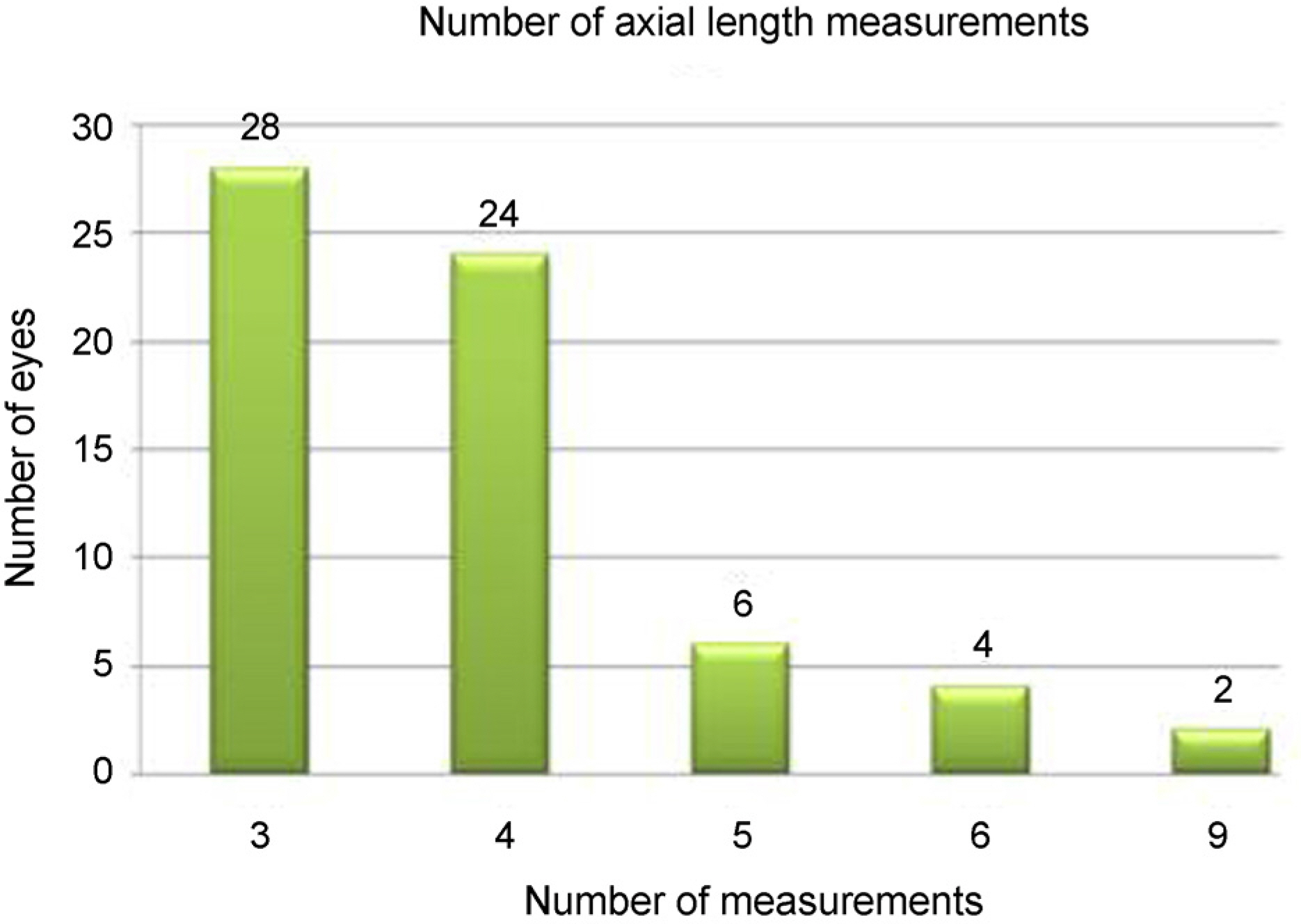J Korean Ophthalmol Soc.
2018 Apr;59(4):369-375. 10.3341/jkos.2018.59.4.369.
Long-term Changes in the Spherical Equivalent and Axial Length in Bilateral High-hyperopia Children
- Affiliations
-
- 1Sungmo Eye Hospital, Busan, Korea. sunei2@naver.com
- KMID: 2409686
- DOI: http://doi.org/10.3341/jkos.2018.59.4.369
Abstract
- PURPOSE
To explore changes in the spherical equivalent refractive error and axial length of both eyes of children with high hyperopia over time.
METHODS
Children with bilateral hyperopia ≥ 4.0 diopters (D) underwent visual acuity testing and comprehensive ophthalmic examinations. The mean age at the first visit was 6.5 years and spherical equivalent refractive error and axial length were measured at least three times over the following year. Axial length was measured using an intraocular lens Master instrument (Carl Zeiss Meditec, Jena, Germany).
RESULTS
The mean annual increase in axial length was +0.21 mm and the mean annual reduction in spherical equivalent refractive error was −0.39 D. Between the ages of 3 and 5 years, the mean annual increase in axial length was +0.36 ± 0.26 mm. In patients aged ≥ 9 years old, the mean annual increase was +0.12 ± 0.09 mm (p = 0.00). The mean annual reduction in spherical equivalent refractive error was −0.53 ± 1.00 D between the ages of 3 and 5 years, but became −.32 ± 0.54 D at age ≥ 9 years old. This difference was not significant (p = 0.11).
CONCLUSIONS
In children with bilateral hyperopia, the spherical equivalent refractive error decreased and the axial length increased with age. The rate of axial length growth was higher in younger children.
Keyword
Figure
Cited by 1 articles
-
Clinical Features of Children with +4.00 Diopters or More Hyperopia Weaning with Age
Seung Yeop Lee, Aram Park, Seung Ah Chung
J Korean Ophthalmol Soc. 2019;60(8):773-779. doi: 10.3341/jkos.2019.60.8.773.
Reference
-
1). Goldschmidt E. Refraction in the newborn. Acta Ophtahlmol (Copenh). 1969; 47:570–8.
Article2). Edelman PM, Borchert MS. Visual outcome in high hypermetropia. J AAPOS. 1997; 1:147–50.
Article3). Ingram RM, Barr A. Changes in refraction between the ages of 1 and 3 1/2 years. Br J Ophthalmol. 1979; 63:339–42.
Article4). Raab EL. Hypermetropia in accommodative esodeviation. J Pediatr Ophthalmol Strabismus. 1984; 21:P64–8.5). Lambert SR, Lynn MJ. Longitudinal changes in the spherical equivalent refractive error of children with accommodative esotropia. Br J Ophthalmol. 2006; 90:357–61.
Article6). Grisham JD, Simons HD. Refractive error and the reading process: a literature analysis. J Am Optom Assoc. 1986; 57:44–55.7). Sorsby A, Leary GA, Richards MJ. Correlation ametropia and component ametropia. Vision Res. 1962; 2:309–13.
Article8). Saunders KJ, Woodhouse JM, Westall CA. Emmetropization in human infancy: rate of change is related to initial refractive error. Vision Res. 1995; 35:1325–8.9). Gwiazda J, Thorn F, Bauer J, Held R. Emmetropization and the progression of manifest refraction in children followed from infancy to puberty. Clin Vision Sci. 1993; 8:337–44.10). Koretz JF1, Rogot A, Kaufman PL. Physiological strategies for emmetropia. Trans Am Ophthalmol Soc. 1995; 93:105–18. discussion 118-22.
Article11). Flitcroft DI. Emmetropisation and the aetiology of refractive errors. Eye (Lond). 2014; 28:169–79.
Article12). Atkinson J, Braddick OJ, Durden K, et al. Screening for refractive errors in 6-9 month old infants by photorefraction. Br J Ophthalmol. 1984; 68:105–12.
Article13). Atkinson J, Braddick O, Robier B, et al. Two infant vision screening programs: prediction and prevention of strabismus and amblyopia from photo- and videorefractive screening. Eye (Lond). 1996; 10(Pt 2):189–98.14). Klimek DL, Cruz OA, Scott WE, Davitt BV. Isoametropic amblyopia due to high hyperopia in children. J AAPOS. 2004; 8:310–3.
Article15). Chen W, Chen J, Zhang F, et al. Visual outcome in isoametropic amblyopic children with high hyperopia and the effect of therapy on retinal thickness. Am J Ophthalmol. 2013; 155:536–43.e1.
Article16). Na SJ, Choi NY, Park MR, Park SC. Long-term follow-up results of hyperopic refractive change. J Korean Ophthalmol Soc. 2005; 46:1704–10.17). Lim HT, Cho SI, Lee SJ, Park SH. Long-term observations on the emmetropization of the high hyperopia. J Korean Ophthalmol Soc. 2002; 43:1230–7.18). Noh JH, Kim SY. Comparison of clinical features in hypermetropic children according to refractive error. J Korean Ophthalmol Soc. 2015; 56:1416–23.
Article19). Paik HJ, Kang KH. The Refractive Errors and axial length in amblyopia. J Korean Ophthalmol Soc. 2002; 43:1040–5.20). Atkinson J, Anker S, Bobier W, et al. Normal emmetropization in infants with spectacle correction for hyperopia. Invest Ophthalmol Vis Sci. 2000; 41:3726–31.21). Yang HK, Choi JY, Kim DH, Hwang JM. Changes in refractive errors related to spectacle correction of hyperopia. PLoS One. 2014; 9:e110663. DOI: 10.1371/journal.pone.0110663. eCollection 2014.
Article
- Full Text Links
- Actions
-
Cited
- CITED
-
- Close
- Share
- Similar articles
-
- Long-term Observations on the Emmetropization of the High Hyperopia
- The Study of the Correlation between Axial Length and Refractive Error in Korean Children
- Clinical Characteristics of Exodeviated Patients with Accomodative Esotropia and Hyperopia without Strabismus
- Incidence and Factors Related to Myopia in Pre-term Infant without Retinopathy of Prematurity
- Choroidal Thickness Changes According to the Refractive Errors and Axial Length in Korean Myopia Patients


